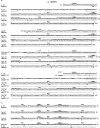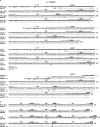Structure of the VH and VL segments of polyreactive and monoreactive human natural antibodies to HIV-1 and Escherichia coli beta-galactosidase
- PMID: 8312222
- PMCID: PMC4638119
- DOI: 10.1093/intimm/5.12.1523
Structure of the VH and VL segments of polyreactive and monoreactive human natural antibodies to HIV-1 and Escherichia coli beta-galactosidase
Abstract
B lymphocytes committed to the production of antibodies binding to antigens on pathogenic bacteria and viruses (natural antibodies) are common components of the normal human B cell repertoire. A major proportion of natural antibodies is capable of binding multiple antigens (polyreactive antibodies). Using B cells from three HIV-1 seronegative healthy subjects, and purified HIV-1 and beta-galactosidase from Escherichia coli as selecting antigen, we generated three natural IgM mAb to HIV-1 and a natural IgM mAb to beta-galactosidase. The three HIV-1-selected antibodies (mAb102, mAb103, and mAb104) were polyreactive. They bound with different affinities (Kd = 10(-6) to 10(-8) M) to the HIV-1 envelope gp160, the p24 core protein, and the p66 reverse transcriptase, but not to the 120 glycosylated env protein. They also bound to beta-galactosidase (Kd approximately 10(-7) M), tetanus toxoid, and various various self antigens. In contrast, the natural mAb selected for binding to beta-galactosidase (mAb207.F1) was monoreactive, in that it bound with a high affinity (Kd < 10(-8) M) to this antigen, but to none of the other antigens tested, including HIV-1. Structural analysis of the VH and VL segments revealed that the natural mAb utilized three segments of the VHIV gene family and one of the VHIII family, in conjunction with VL segments of the V lambda I, V lambda II, V lambda III, or V kappa IV subgroups. In addition, the natural mAb VH and VL segments were in unmutated or virtually unmutated (germline) configuration, including those of the monoreactive mAb207.F1 to beta-galactosidase, and were identical or closely related to those utilized by specific autoantibodies or specific antibodies to viral and/or bacterial pathogens. Thus, the present data show that both polyreactive and monoreactive natural antibodies to foreign antigen can be isolated from the normal human B cell repertoire. They also suggest that the VH and VL segments of not only polyreactive but also monoreactive natural antibodies can be encoded in unmutated or minimally mutated genes, and possibly provide the templates for the specific high affinity antibodies elicited by self or foreign antigens.
Figures





References
-
- Boyden S. Natural antibodies and the immune response. Adv. Immunol. 1964;5:1. - PubMed
-
- Michael JG. NaturaJ antibodies Curr. Top. Microbhl. Immunol. 1969;48:43. - PubMed
-
- Avrameas S. Natural autoantibodies: from 'horror autotoxicus' to 'gnothi seuton'. Immunol. Today. 1991;12:154. - PubMed
-
- Riboldi P, Kasaian MT, Mantovani L, Ikematsu H, Casali P. Natural antibodies. In: Bona CA, Siminovitch K, Zanetti M, Theofilopoulos AN, editors. The Molecular Pathology of Auto-immune diseases. Gordon and Breach; Philadelphia: 1993. p. 45.
-
- Casali P. Immunoglobulin M. In: Roitt IM, Delves PJ, editors. Encyclopaedia of Immunology. II. Academic Press; London: 1992. p. 743.
Publication types
MeSH terms
Substances
Associated data
- Actions
- Actions
- Actions
- Actions
- Actions
- Actions
- Actions
- Actions
Grants and funding
LinkOut - more resources
Full Text Sources
Other Literature Sources

